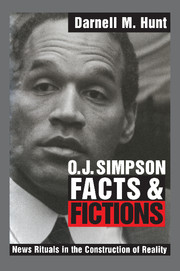Book contents
- Frontmatter
- Contents
- List of figures
- List of tables
- Acknowledgments
- Introduction: Knowing O.J.
- Part I Theory
- Part II News construction
- 3 Press rites and O.J. wrongs: behind the scenes at “Camp O.J.”
- 4 Celebrating the process: O.J. and KTLA-TV
- 5 (Re)affirming official sources: O.J. and the Los Angeles Times
- 6 (Il)legitimate transgressions: O.J. and the Los Angeles Sentinel
- Part III Audience reception
- Part IV Conclusions
- Appendix 1 Page-one narratives, Los Angeles Times, January 25–October 4, 1995
- Appendix 2 Page-one O.J. narratives, Los Angeles Sentinel, January 25–October 5, 1995
- Appendix 3 Emerging discussion themes, by group, March 30, 1995
- Appendix 4 Emerging discussion themes, by group, August 1, 1995
- Appendix 5 Transcript of Primetime text
- Appendix 6 Transcript of KTLA text
- Appendix 7 Logistic regression of perceptions about Simpson's innocence or guilt on race, gender, education, family income, interviewer race, and perceptions of criminal justice system bias
- Notes
- References
- Index
3 - Press rites and O.J. wrongs: behind the scenes at “Camp O.J.”
Published online by Cambridge University Press: 22 September 2009
- Frontmatter
- Contents
- List of figures
- List of tables
- Acknowledgments
- Introduction: Knowing O.J.
- Part I Theory
- Part II News construction
- 3 Press rites and O.J. wrongs: behind the scenes at “Camp O.J.”
- 4 Celebrating the process: O.J. and KTLA-TV
- 5 (Re)affirming official sources: O.J. and the Los Angeles Times
- 6 (Il)legitimate transgressions: O.J. and the Los Angeles Sentinel
- Part III Audience reception
- Part IV Conclusions
- Appendix 1 Page-one narratives, Los Angeles Times, January 25–October 4, 1995
- Appendix 2 Page-one O.J. narratives, Los Angeles Sentinel, January 25–October 5, 1995
- Appendix 3 Emerging discussion themes, by group, March 30, 1995
- Appendix 4 Emerging discussion themes, by group, August 1, 1995
- Appendix 5 Transcript of Primetime text
- Appendix 6 Transcript of KTLA text
- Appendix 7 Logistic regression of perceptions about Simpson's innocence or guilt on race, gender, education, family income, interviewer race, and perceptions of criminal justice system bias
- Notes
- References
- Index
Summary
Few of us in the press corps were ever rational about it. The case devoured our waking hours and invaded our dreams. After the not-guilty verdict, many trial reporters were physically sick for weeks – earaches, flu, back pain. Was it just exhaustion – or something else? Many left the newspaper business altogether.
(I am one of them.)I was present at the downtown Los Angeles courthouse on the morning the not-guilty verdicts were read, observing the hurried activities of newsworkers. The Simpson case was clearly the news story to end all news stories. Two-hundred and fifty phone lines had been installed in the court's twelfth-floor pressroom to accommodate the day-to-day communications needs of the 1,159 credentialed newsworkers who covered the case (Coffey 1995). In addition to the suffocating presence of US media, news operations from more than a dozen foreign nations had also sent newsworkers to cover the latest developments. Of the fifty-eight highly coveted seats in Judge Ito's courtroom, twenty-four had been set aside for this corps of newsworkers (Elias and Schatzman 1996). Seven of these seats had been permanently assigned to the Los Angeles Times (see chapter 5), two book authors, and four other mainstream news operations. The remaining seventeen seats were rotated between two other book authors and thirty-nine other news operations. One of these less-favored news operations was the largest black-owned newspaper in the West, the Los Angeles Sentinel (see chapter 6).
- Type
- Chapter
- Information
- O. J. Simpson Facts and FictionsNews Rituals in the Construction of Reality, pp. 87 - 106Publisher: Cambridge University PressPrint publication year: 1999



